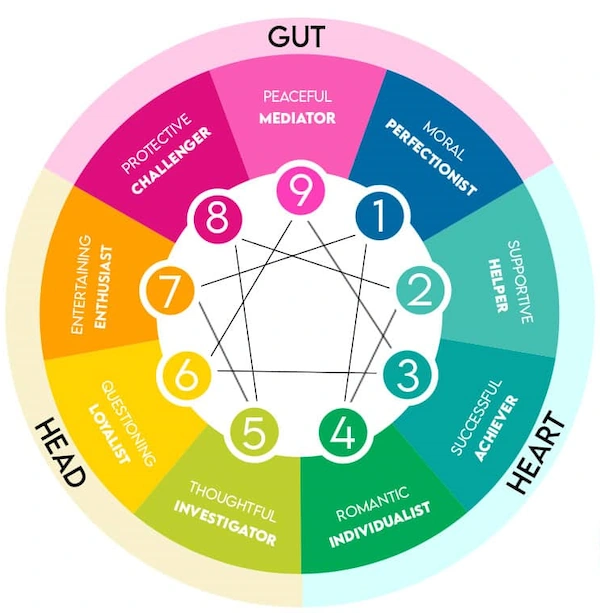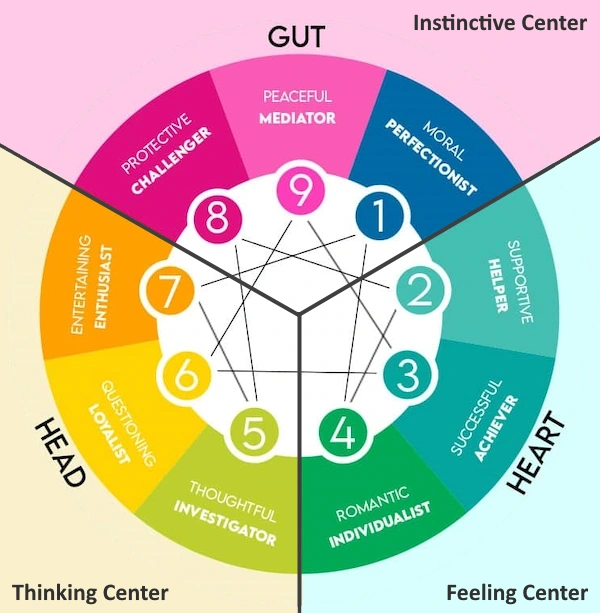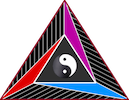
The Enneagram is a personality typing system that categorizes individuals into nine distinct types, each representing different motivations, fears, and behavioral patterns. This model is not only used for understanding personality but also has deep spiritual implications and connotations.
Origins of the Enneagram
The origins of the Enneagram can be traced back to various philosophical and spiritual traditions, including early Christian mysticism. The contemporary understanding of the Enneagram was significantly shaped by figures such as Oscar Ichazo and Claudio Naranjo in the mid-20th century. The structure of the Enneagram consists of a geometric figure that illustrates how these nine types are interconnected. Each type is associated with specific emotional responses and coping mechanisms.
Spiritual Dimensions of the Enneagram
One of the key aspects that set the Enneagram apart from other personality models is its integration with spiritual growth. Each type reflects an aspect of divine nature, suggesting that understanding one’s type can lead to greater self-awareness and a deeper connection with God or a higher power. For instance, Type 1 (the Perfectionist) embodies God’s goodness, while Type 2 (the Helper) reflects God’s love.
Personal Growth Through Self-Awareness
The process of identifying one’s Enneagram type serves as a pathway for personal development. By recognizing their core beliefs and motivations, individuals can begin to untangle unhealthy patterns that may have developed over time due to life experiences or family dynamics. This journey often involves confronting uncomfortable truths about oneself, which can lead to significant transformation.
The Structure of the Enneagram
The Enneagram is visually represented as a nine-pointed geometric figure, which consists of a circle with nine equidistant points around its circumference. Each point corresponds to one of the nine personality types.

Type One: The Perfectionist
Type Ones are principled, purposeful, and self-disciplined individuals who strive for integrity and improvement. They have a strong sense of right and wrong and often hold themselves to high standards. Their motivation is driven by a desire to avoid mistakes and be morally good, which can lead them to be critical of themselves and others. They tend to see the world in black-and-white terms, making them appear rigid or inflexible.
Strengths: Ethical, dedicated, reliable, organized.
Faults: Critical, judgmental, can be overly controlling.
Basic Fear: Being corrupt or evil.
Basic Desire: To be good and have integrity.
Type Two: The Helper
Type Twos are caring, interpersonal individuals who thrive on being needed. They are empathetic and often prioritize the needs of others over their own. Their motivation stems from a deep-seated need for love and appreciation, which can lead them to become overly involved in the lives of others while neglecting their own boundaries.
Strengths: Warm-hearted, generous, supportive.
Faults: Overly accommodating; may struggle with self-neglect.
Basic Fear: Being unworthy of love.
Basic Desire: To feel loved.
Type Three: The Achiever
Type Threes are success-oriented individuals who seek validation through accomplishments. They are highly driven and focus on image management; they often equate their self-worth with their achievements. This can lead them to prioritize appearance over authenticity and may cause feelings of inadequacy when they do not meet their goals.
Strengths: Adaptable, goal-oriented, charismatic.
Faults: Overly focused on image; may lack authenticity.
Basic Fear: Being worthless or insignificant.
Basic Desire: To feel valuable.
Type Four: The Individualist
Type Fours are introspective and sensitive individuals who seek identity through uniqueness. They value deep emotional experiences and often feel different from others. Their quest for meaning can lead them into moodiness or feelings of inadequacy as they grapple with their emotions.
Strengths: Creative, emotionally aware, authentic.
Faults: Can be self-absorbed or moody; may struggle with envy.
Basic Fear: Having no identity or personal significance.
Basic Desire: To find meaning based on inner experience.
Type Five: The Investigator
Type Fives are analytical thinkers who prioritize knowledge and understanding. They tend to withdraw from social interactions to conserve energy for intellectual pursuits. Their independence can sometimes come off as aloofness or detachment from emotional connections.
Strengths: Insightful, perceptive, innovative.
Faults: Withdrawn; struggles with emotional expression.
Basic Fear: Being useless or helpless.
Basic Desire: To be competent.
Type Six: The Loyalist
Type Sixes are committed individuals who value security and loyalty. They often anticipate worst-case scenarios due to anxiety about safety and support. This vigilance makes them responsible but can also lead to self-doubt if they feel unsupported by others.
Strengths: Responsible, loyal, practical.
Faults: Anxious; may struggle with indecision or trust issues.
Basic Fear: Being without security or support.
Basic Desire: To have security.
Type Seven: The Enthusiast
Type Sevens are adventurous individuals who seek happiness through new experiences. They avoid emotional pain by staying busy with activities that bring joy but may struggle with commitment due to fear of confinement or boredom.
Strengths: Spontaneous, versatile, optimistic.
Faults: Scattered; may overextend themselves in pursuit of pleasure.
Basic Fear: Feeling trapped or experiencing pain.
Basic Desire: To be happy.
Type Eight: The Challenger
Type Eights are assertive leaders who seek control over their environment. They value strength and resilience but can come off as confrontational when asserting their will. Their protective nature drives them to stand up for those they perceive as weaker than themselves.
Strengths: Direct, resourceful, protective.
Faults: Controlling; may struggle with vulnerability or tenderness.
Basic Fear: Being harmed or controlled by others.
Basic Desire: To protect themselves and others.
Type Nine: The Mediator
Type Nines are easygoing individuals who prioritize harmony in relationships. They avoid conflict at all costs but may become complacent in doing so. Their desire for peace can lead them to neglect their own needs until they reach a breaking point where they might express suppressed anger unexpectedly.
Strengths: Accommodating, calm, genuine listeners.
Faults: Can become too complacent; may suppress anger until it explodes unexpectedly.
Basic Fear: Being disconnected or lost within themselves or in relationships with others.
Basic Desire: To have peace in their internal world.
The Three Centers of Intelligence
The Enneagram organizes these types into three centers of intelligence based on how they primarily process information.

Instinctive Center (Types Eight, Nine, One)
This center focuses on gut reactions primarily dealing with anger and instinctual responses to perceived threats. Individuals in this center often react based on their immediate feelings about safety or danger, reflecting a strong connection to their bodily sensations and instincts (The Gut Triad).
Feeling Center (Types Two, Three, Four)
This center revolves around emotions related particularly to shame and the need for acceptance. Those in this group prioritize relationships and emotional connections, often valuing empathy and interpersonal dynamics over purely logical reasoning (The Heart Triad).
Thinking Center (Types Five, Six, Seven)
This center engages thoughts related to fear and the desire for security. Individuals here tend to analyze situations thoroughly before taking action; they often seek understanding and safety through knowledge and intellectual exploration (The Head Triad).
Each center reflects how individuals cope with their dominant emotion associated with their type; anger for Instinctive types, shame for Feeling types, fear for Thinking types. This categorization provides further insight into their motivations behind actions.
Wings in the Enneagram
In addition to identifying one’s primary type within the Enneagram framework, individuals often exhibit traits from adjacent types known as “wings”. For example: A Type Nine may have either an Eight-wing (which adds assertiveness) or a One-wing (which adds conscientiousness).
This concept allows for greater nuance in personality assessment as it acknowledges that people are not purely one type but rather a blend influenced by neighboring types. Wings add depth by highlighting variations within each primary type’s characteristics based on individual experiences.
Levels of Development
Each personality type exists along a continuum characterized by three levels: healthy, average, and unhealthy.
Healthy Levels: These reflect positive traits such as liberation from fears associated with one’s type leading towards growth; healthy Ones might become more accepting while healthy Twos could learn self-care practices without losing empathy for others.
Average Levels: These indicate more common behaviors like interpersonal control but can lead toward dysfunction if unchecked; average Threes might become overly competitive while average Nines could struggle against complacency leading them away from action-oriented choices necessary for progress.
Unhealthy Levels: These represent detrimental behaviors that can lead toward psychological breakdowns; unhealthy Eights might exhibit aggression, while unhealthy Sevens could fall into escapism through substance abuse or reckless behavior patterns due largely because they fear facing reality directly.
Understanding where an individual falls within these levels provides insights into their current state of functioning along with areas ripe for growth opportunities, essentially guiding personal development journeys effectively.
Directions of Integration and Disintegration
The Enneagram illustrates how each type behaves under stress (disintegration) versus when they are growing (integration). Each type connects to two other types through lines on the diagram; one line indicates growth towards another type’s strengths, while the other shows regression towards less desirable traits during stressful times.
For instance, a Type One under stress may take on negative qualities associated with Type Four, becoming moody instead of striving towards improvement.
Conversely, though, when healthy a Type One integrates towards Type Seven embodying spontaneity and joyfulness.
This dynamic aspect emphasizes that personality is not static and it evolves based upon circumstances encountered throughout life.
Applications of the Enneagram
The applications of the Enneagram extend far beyond mere classification; it serves various purposes, including those listed below.
Personal Development
The Enneagram is widely utilized for personal growth and self-awareness. By understanding one’s type, individuals can identify their strengths and weaknesses, which facilitates targeted personal development. For instance, a Type 1 may work on issues related to perfectionism and rigidity, while a Type 7 might focus on commitment and follow-through. This self-awareness allows individuals to set realistic goals for improvement and fosters emotional intelligence by helping them recognize how their behaviors impact themselves and others.
Relationship Enhancement
In interpersonal relationships, the Enneagram provides insights into compatibility and communication styles. Understanding the different types can help partners navigate conflicts more effectively. For example, a Type 2 may need to learn how to assert their needs without feeling guilty about it when paired with a Type 8, who values directness. Couples can use this knowledge to foster empathy and patience, leading to healthier dynamics.
Team Dynamics in Workplaces
Organizations increasingly adopt the Enneagram as a tool for improving team dynamics. By assessing the personality types of team members, leaders can create balanced teams that leverage diverse strengths. For instance, knowing that a team includes both Type 3s who are goal-oriented and Type 6s who prioritize security can help managers assign roles that align with these traits. This understanding enhances collaboration, reduces conflict, and increases overall productivity.
Counseling Practices
Mental health professionals often incorporate the Enneagram into therapeutic practices. It serves as a framework for understanding clients’ behaviors and motivations. Therapists can use this model to tailor interventions based on an individual’s type; for example, a Type 4 may benefit from exploring feelings of inadequacy through creative expression in therapy sessions. The Enneagram also aids counselors in building rapport with clients by recognizing their core fears and desires.
Spiritual Growth Initiative
The Enneagram has roots in spiritual traditions and is used as a tool for spiritual development. Many practitioners view it as a means of achieving greater self-acceptance and compassion towards others. Each type has specific spiritual challenges; for example, Type 5 might struggle with isolation while seeking deeper connections with others through mindfulness practices or community involvement. Engaging with the Enneagram in this way encourages individuals to transcend their ego-driven behaviors toward more fulfilling spiritual lives.
Conclusion
By recognizing one’s own personality type as well as those of peers, family members, and colleagues, individuals can enhance communication and empathy in both personal and professional relationships. This understanding contributes to a richer collective life experience. In summary, the Enneagram serves not only as a framework for classifying personalities but also offers deep insights into human behavior. It promotes personal development while enhancing interpersonal relationships through a greater comprehension of one’s own motivations and those of others.
Now all you have to do is enjoy our ENNEAGRAM PERSONALITY MINI-TEST

